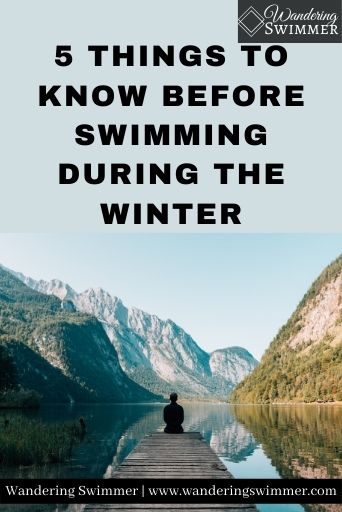Written By: Chevron
Believe it or not, some swimmers do train outside during the winter. Either at an outdoor pool, or a lake or an ocean, if conditions allow for it. Some outdoor pools are heated enough for swimmers to ‘comfortably’ swim outside in the winter. Although, comfortable is relative and what’s warm to some is cold to others.
But what if you’re swimming in an open body of water? Or the pool you’re at isn’t heated? Training outside in the winter when the water temperature isn’t regulated requires a bit more effort. But for some, it’s well worth the effort.
Please note that this article is more about open water, competitive, and fitness/lap swimming during the winter season. This isn’t advice for winter swimmers (those that swim outdoors in very cold bodies of water). If you’re looking for advice or tips on winter swimming, check out Outdoor Swimming Society.
Disclaimer: We are not healthcare providers or physicians. These are only meant as a suggestion and starting point if you’re looking to start swimming outside during winter. Swimming in very cold water can cause health risks, such as shock, hypothermia, asthma attacks, and death. Please consult a licensed professional if you’re considering winter swimming. Please see our disclaimer for more information.
Disclosure: This post may contain affiliate links, meaning we earn a small commission at no cost to you if you purchase something through one of our links. As an Amazon Associate, we earn from qualifying purchases. Please check out our disclosure page for more information.

How Cold is Too Cold?
Honestly, it’s not straightforward and it varies by each individual and their tolerance to cold. To give you an idea, below are some temperature ranges from governing sporting bodies:
- Most competitive swimmers train in water that’s anywhere from 77-83 degrees (25-28C).
- FINA guidelines state that the water temperature for Olympic swimming must be at 79 (26C).
- US Masters Swimming doesn’t hold open water competition in water that’s less than 61 degrees (16C).
By the list above, you can see that it’s a wide range definition on ‘how cold is too cold. In my experience, most individuals find that anything under 82-83 degrees is cold. Lastly, everyone’s cold tolerance is different. Don’t let the water tolerance of one swimmer persuade you to keep going. Again, know your limits.
What Should You Know Before Swimming Outdoors in Winter?
If it’s your first time swimming outside in cold water, we wouldn’t recommend going into water that’s under 75-77 degrees (23-25C). At least not until you’ve had some experience in colder water. The key is to look at the various options that exist within the sport/exercise and address each one. Otherwise, you might put yourself at risk.
Some things to consider are your overall health, the way your body handles the cold, and where you’re swimming. If you have an existing health concern and/or you don’t handle cold well, you should reconsider swimming outside in the winter.
If you’re going to swim outdoors in winter in water that’s not heated, here are some things to know. For more guidelines on open water swimming, check out this resource from USA Swimming. Outdoor Swim Society also has a good guide for Cold Water Temperature (Note, the temperatures are listed in Celsius).
1. Health
Before heading out to swim in unheated water, always check with your healthcare provider. Swimming in cold water isn’t for everyone. Especially if you have certain medical conditions, such as asthma or cardiovascular problems, to name a few.
Cold water can make certain medical conditions worse. Because of this, we highly encourage you to speak with your healthcare provider before taking the plunge. It could save your life.
2. Safety First
When you’re in or around water, you should always use caution. This is especially true if you’re swimming in a place that doesn’t have lifeguards. Keeping yourself safe is more than just knowing how to swim. It’s about checking the weather, knowing your limits, swimming smart, and staying visible.
Some safety tips for swimming outside (for any time of the year) are:
- When swimming, always swim with other swimmers. Even strong or experienced swimmers can find themselves in trouble. And if you’re alone in the water, your chances of drowning increase if something happens
- Always use a buddy system and check-in with each other. And keep open, honest communication about how you’re feeling
- When you’re swimming outside, wear a brightly colored swim cap to make yourself easier to spot. Additionally, use a colorful and bright open water swim buoy. This helps other people in the water notice you
- Know the temperature of the water before you get in so you can ensure you’re swimming at a safe temperature
- Lastly, don’t let pride get in the way of your safety. If you can’t handle the water temperature safely in a regular suit, try a thermal wetsuit. And if that doesn’t keep you warm, you probably shouldn’t be swimming outside in that water temperature.
Everyone has a limit as to what they can stand. Some can build their tolerance while others have a harder time. Be smart about your actions. Consult local outdoor swim groups for advice and help.
3. Check the Weather
Always check the weather before heading out for your swim and throughout your swim. The weather can change quickly and you don’t want to be caught unprepared. If you’ve never swam outside in bad weather conditions (such as foggy or rainy weather) use caution and your best judgment.
4. Know Your Limits
Everyone handles cold differently and cold water isn’t the same as cold air. Before getting into the water, you need to have an idea of what your limits are. The best way to do this is to keep swimming from summer through fall and into winter if conditions allow. This lets your body acclimate gradually as the weather/temperatures change.
More Content for You: 7 Reasons to Wear Goggles When you Swim
If you can’t do this, it may be best to wait until the following fall season so you can acclimate easier. Can’t wait until then? Start slow and stay in for short periods before gradually increasing the time spent in the water. Sometimes all you can do is splash around in the shallow water for a few days. And that’s okay. Getting acclimated to cold water takes time and isn’t something you should rush.
5. Ease into the Water
It may seem easier to jump into the water to get over the shock. But the best way is to enter the water slowly. Doing this helps prevent you from having that sharp gasp that most people do when they experience cold water.
Cold water swimmers suggest splashing your legs, arms, and neck with the water to help your body avoid some of the shock. You may need to spend more time acclimating certain sections of your body than others.
10 Tips for Swimming Outdoors in Winter
1. Warm Clothes and Staging
It should go without saying, but wear and pack warm clothes if you’re swimming outside in winter. You’ll also want clothes that can handle getting wet, such as a parka or robe, for right after your swim. Slip a hat on right after you get out of the pool. Bring extra socks and towels, and layer up to stay warm.
I’ve also found that it helps when I stage my belongings so that my parka and towel are on top of my bag for easy access. This way, I’m not digging around for anything after I get out of the water.
Related articles:
- Best Swim Parkas for Water Enthusiasts
- A Swimmer’s Review of Arena’s Team Line Parka
- Best Warm Clothes to Stay Warm at Swim Meets
2. Cap Up
Get your cap and goggles on before you start removing any layers. I always put my cap and goggles on first before removing my layers. The less time you have to expose yourself to the cold air, the better. Take this time to set out any gear you plan to use behind your lane, too. If you’re swimming in open water, inflate your swim buoy before getting into the water.
More Content for You: Your Ultimate Swim Cap FAQ
3. Wear Sandals up to the Water
Keep your feet warm by wearing your sandals up to the water to avoid contact with the tile or concrete. And dunk them in the water just before getting out to warm them up after sitting in the cold for so long. Just be careful not to slip on the wet deck or ground.
4. Take Extra Time to Warm Up
You should always stretch well before getting in the water and get your heart rate up. But this is especially important when the weather is cold, as it’ll help warm up your muscles. Once in the water, make sure your muscles are feeling loose and ready to swim. If you need to, get in some extra laps. Doing this can help lessen the risk of any muscle cramps.
5. Appropriate Swimwear
If you’re swimming in open water, know your limits and when you’ll need to wear a wetsuit. Or any other type of thermal/neoprene wear. Such as thermal gloves, booties, and earplugs. Neoprene comes in different levels of thickness. With 1mm being the thinnest, and 3 – 5mm being the thickest and warmest option.
Check the weather and water temperature before leaving and again when you arrive. Pack extras of what you might need. Just in case conditions change before your swim.
6. Double Cap
When swimming in open water, double cap with a neoprene swim cap and a bright latex one. This will help keep your head warm and also ensure that you’re spotted easily. For those that swim in the pool, wearing two regular caps can also help you retain some heat. You can base with latex and use a silicone one as your outer cap. You can always take off a layer if you start to get too warm.
More Content for You: 8 Reasons Your Swim Cap Slides Off
7. Hydrate!
It may be hard to drink when you’re cold but you need to ensure you’re staying hydrated. Even if the water is cold or you’re swimming in winter, you still sweat and lose fluids. Keep your reusable water bottle handy and make sure you’re drinking from it!
8. Be Aware of Your Body
Educate yourself on the signs of hyperthermia and overheating. Both of these can be issues when you’re swimming depending on the water temperature. Know the warning signs and monitor yourself during your swim.
If you feel confused, dizzy, have slurred speech, or feel like you can’t move your legs/body, get out of the water and let your coach know. These can be signs of hyperthermia or overheating, and you should take a moment to take care of yourself.
9. Safety
We said it earlier but it bears repeating. Safety is key when swimming. No matter what time of the year or temperature. Swim with others and never swim by yourself. If you’re swimming in open water, make sure you’re wearing and using brightly colored buoys and caps.
10. After Swim Care
When coming from cold water in the winter, take care with how you warm back up after your swim. Have a hot drink ready and get wrapped up quickly to prevent afterdrop. It’s tempting to jump straight into a hot shower. However, doing so can mess with your blood pressure and could cause you to faint if you’re not careful.
Outdoor Swim Society has a great article about afterdrop and tips to warm up safely after a cold water swim.
Indoor Swimming in the Winter
What about swimming inside?
If you’re swimming indoors, where the temperature of the pool and surroundings are controlled, yes, it’s okay to swim in winter. Competitive and lap swimmers train year-round. And for most competitive swimmers, winter training is the longest and hardest training they’ll do all year.
More Content for You: What is Swimmer’s Ear?
Most indoor swim facilities are heated (both air and water), although they probably won’t be as warm as you’d like when you first get in.
5 Benefits of Swimming in the Winter
With all the things to take into consideration when swimming in the winter, is it worth it to keep swimming when it’s cold? We like to think there is! 🙂 There are several benefits to swimming during the winters months, such as:
- Help overcome Seasonal Depression
- Keeps you active
- Sense of accomplishment
- Burn calories over the holidays
- Maintain your swimming skills for the warmer months
As always, happy swimming!
Chevron
Bonus Content
4 Ways to Prevent Swimmer’s Ear: Swimmer’s ear can be a painful experience if left untreated. That said, there are steps you can take to help prevent swimmer’s ear. Here are 4 ways to prevent swimmer’s ear.
Swimming on Your Period (And Why You Should): Yes, you can swim on your period! From one menstruating swimmer to another, here are some frequently asked questions I get about swimming on your period.

Want to Improve at the Pool?
Join swimmers and swim parents to receive my free newsletter and receive a free Swimming Glossary e-book as a thanks!
Every month you’ll receive tips and coaching to help you find success at the pool.
About

Chevron is a current competitive swimmer with almost 20 years of experience at the local, national and international level. A current USA Swimming and US Masters Swimming athlete, she’s committed to providing guidance to all levels of swimmers and believes that everyone should know how to swim.